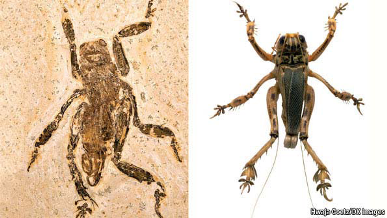A new fossil shows that evolution does not always mean change
WHEN a coelacanth, a type of lobe-finned fish once considered the missing link between fishand amphibians, was found off the coast of South Africa in 1938, it came as a shock topalaeontologists. Until then, the most recent traces of such a creature had been in rocksdating from the last days of the dinosaurs, 65m years ago. It was, in its way, as surprising asif a live Tyrannosaurus had been found hiding in an obscure part of Montana. Now the sameexperience is hitting palaeontologists again—but this time in reverse. Instead of finding a“living fossil” identical to an ancient beast, they have found a real fossil identical to a modernone.The fossil in question, a 100m-year-old specimen from north-east Brazil, belongs to the genusSchizodactylus. These are large, carnivorous, cricket-like insects whose feet splay out wildly indifferent directions. Modern Schizodactylus use their feet like snowshoes, to help them remainstable as they travel over sandy terrain in search of prey.If the new fossil—whose discovery has just been published in ZooKeys by Sam Heads of theIllinois Natural History Survey and Léa Leuzinger of the University of Fribourg, in Switzerland—were merely similar to modern splay-footed insects, the find would not be particularlysurprising: it simply demonstrates a phenomenon called evolutionary stasis, in which aspecific type of body form hangs around for a long time. What is surprising is just how staticSchizodactylus has been.Evolutionary stasis is fairly common at the higher levels of the Linnaean system of biologicalclassification (class, order and family). Natural selection hits on a good design. That design isthen adopted in slightly different forms by species after species. The shelled bodies of turtles,for example, evolved between 250m and 200m years ago, while the body plans of scorpionshave been around for more than 400m years. That does not mean, however, that a zoologistwould mistake a 200m-year-old turtle or a 400m-year-old scorpion for any species now alive.What is remarkable about the new find is that it is so similar to modern animals that it can be4/17/2011 Palaeontology: Splay-footed, not flat-f…economist.com/node/18111764/print 1/2About The Economist online About The Economist Media directory Staff books Career opportunities Contact us Subscribe [+] Site feedbackCopyright © The Economist Newspaper Limited 2011. All rights reserved. Advertising info Legal disclaimer Accessibility Privacy policy Terms of use Helpfrom the print edition | Science and Technologyassigned to an existing genus—the lowest level of Linnaean classification above a species—rather than just to some higher taxonomic group. That is rare indeed. Even the moderncoelacanth, on closer examination, had to be put in a different genus from any known fossil.Clearly the body plan of Schizodactylus is not merely good, but optimal, at least for theenvironment the animal lives in. Alas for Schizodactylus, the sandy deserts it prefers haveretreated from north-eastern Brazil and its optimality there has vanished. But its discoveryshows better what this part of the world was like 100m years ago—and also illustrates animportant point about evolution that is often forgotten in biologists’ understandable focus onthe development of novelty. The first rule of natural selection is: “If it ain’t broke, don’t fix it.”
The Economist has partnered with Copyright Clearance Center’s Rightslink service to offer a variety of options for reusing The Economist content. If you are interested in an annual license or syndication agreement, for more information please contact The Economist Rights and Syndication department.
